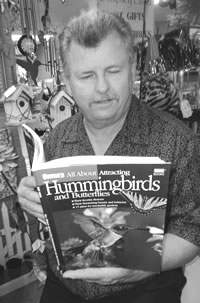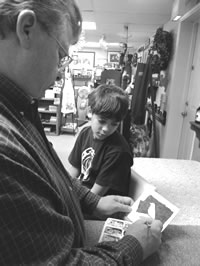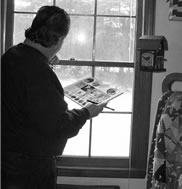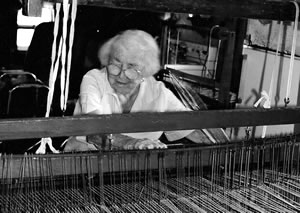As guest columnist for the Lexington Dispatch, Dempsey penned several articles which are included here. By reading them it will be evident that he is a painter and not a writer however you will gain insight on topics important to him.
"Take some time to enjoy everyday beauty"

Dempsey Essick
Have you ever driven down a road that you have traveled many times before and all at once you notice a beautiful old house with trees and a split-rail fence, a building or, perhaps, an old oak tree that you've never taken note of before? It had been there all along, but you just didn't see it.
I've done the same thing. We get so busy taking care of business that, as the old saying goes, we don't take time to smell the roses. We let the beauty in everyday things slip right by. Life is short and difficult at best, and if we don't take the time to look around and appreciate the world around us, life will get dull and boring. And a boring and unthankful person is usually an unhappy person.
Slow down a bit and take the time to appreciate God's creations and to count your blessings. Below I have listed a few things to give you an idea of what I'm talking about.
No. 1: Expectant mothers are beautiful beyond words. There is a glow and radiance about them that is very special. I love to be around them and sense their excitement as they anticipate their special gift from God. Our daughter, Beth, is about to give birth to our first grandchild, and it is a real blessing to look at her and hear her talk to her unborn child. She has never been more beautiful.
No. 2: I love daylilies. They are one of the most special and most common flowers around, but they can hold their own in any company. The one thing that makes daylilies special, aside from the fact that they are very colorful and showy, is that each bloom lasts for only one day, and then it is gone. Tomorrow's blossom will be fresh and new.
No. 3: I like birds. Hummingbirds fascinate me the way they can seem to appear out of nowhere, stop in mid-air then zoom off in the blink of an eye. Goldfinches hanging upside-down to get ripe sunflower seeds will make you laugh especially when other birds try it and can't perform the trick. But of all the birds I think I like bluebirds best.
Bluebirds mate for life, they stay with you through the winter, and you can build a relationship with them. They choose to raise their young in weathered wooden boxes, fence-post holes and even gourds. I love it when my bluebirds await me at the feeding station, anticipating the delicious meal worms I bring.
No. 4: Barns are special places, and I love to paint them. When I go into a barn I look at everything from the hayloft ladder to the cattle stalls with the boards rubbed smooth from cattle scratching themselves against the corners. I love the old gates with handmade latches. If you want to go back in time, just go visit an old barn.
No. 5: Old barns make me think of wooden boards. No two boards are exactly alike. Each board has its own pattern of knots and grain, and I love to include them in my paintings whenever possible, especially those that have turned silver-gray with age.
No. 6: Butterflies are amazing. I recently studied the Tiger Swallowtail in preparation for a painting, and I was amazed by its delicate, well-defined colors and graceful moves. Butterflies can fly all around you and never make a sound. I stand in awe of this silent beauty.
No. 7: Have you ever studied a simple maple leaf? Did you note the shape and the veins? No two leaves are exactly the same, and each one is a delicate piece of artwork all on its own
I suppose what I'm trying to say is, and I know it has been said many times before, life is short, take time to smell the flowers.
"The arts remain important in our schools"

Nicholas Gaines observes
Dempsey as he paints
I believe that a society without deep roots in the arts is a society without a heart. The arts bring richness and meaning to our souls. Think how dry our lives would be without books, music, dance, poetry, movies, plays, paintings, sculpture, wood carving, basket making, quilting and all the other skills and activities that feed our souls and make us happy.
How dull would a Friday night football game be without the band and the cheerleaders and the flag girls? Think of what marching bands, floats, singers and dancers bring to a parade. Music brings joy into our lives every day, and we wouldn't have it any other way.
It is imperative that our young people get a chance to find out what their talents are and to develop them. The sciences are vital, but so are the arts. Students must be encouraged to explore and exploit their talents, and it is up to the schools to expose those hidden talents and encourage the students to get the most out of life with a balance of art and science.
I'd like to share my personal story to help make the point on the importance of the arts in our schools. I was just an average student. I tried hard and made a good effort in my early years. I could get by in reading, writing, spelling and math, but the bulletin boards, art classes, singing, crafts and Christmas plays really captured my attention. Because I was good at something it helped me to focus on the other subjects. Some students excelled in academic studies; art was something I could excel in.
As a matter of fact a couple of my elementary school teachers had a great effect on my life. As a first-grader at the Welcome School I won my first blue ribbon in art, and I can remember Ann Corn and Sally Hackney both encouraging me, saying "Dempsey, you have talent, and if you work hard you can do something with it one day." Carla Robbins in middle school and Brenda Vickers in high school kept pushing me to develop my artistic talent. I'm thankful that the arts were promoted when I was in school in the 1960s and '70s. It was a big stepping stone toward my future art career.
Those teachers had an enormous influence on my future, just as teachers in the arts can influence students today. It would be a pretty dull world if our young people emerged from school without the appreciation of a beautiful picture or the little shiver that goes up your spine when you hear a particular musical phrase. Riches are not just the size of your bank account. The really rich are those who can appreciate the inspiration that led to a beautifully designed building, or an expertly played jazz trumpet, or a beautifully written book, a painting that stops you dead in your tracks, or a piece of sculpture that you walk all around just to see each exquisite line.
As we look at how we allot money and resources for our schools, let's be sure to include the arts, because artistic talent is a gift from God and is meant to be used.
"Birds put on a show when snow descends on county"
My opinion of the perfect snowy day is to paint while enjoying the company of my friends, the birds, at their feeding station outside my studio window. When I awakened Sunday, January 25, I saw a flurry of activity outside the window and realized the weatherman had hit it on the head when he said that snow was on the way. As the small flakes fell I hustled outside to fill my feeders and bird baths so the birds would have plenty to eat and to drink. By the time the ground was covered and the snow had turned to a light drizzle, which was freezing on the trees and electric lines, the show around the feeders was going full blast.
It was a show worth paying to see. The smaller finches and sparrows and wrens were crowded together fluttering their wings and calling each other names and generally raising a ruckus when the bigger blue jays and mocking birds would swoop in looking very regal, and the smaller birds would have to retreat to nearby tree limbs until the coast was clear once again. While this back-and-forth show was going on the very small nuthatches and chickadees would swoop in to grab a sunflower seed and retreat to a nearby limb to open and devour the seed then return for another, sometimes snatched, like a pickpocket, right from under one of the larger birds. Then, in a flash of gray and red a red-bellied woodpecker would swoop in from the trees, and everyone else would clear out of the way of that formidable beak, which is like a short dagger. The woodpecker would scoop up a few seeds and return to the tree line, and all the rest would resume the party.
I smile as I work on my painting and enjoy the sounds of the celebration. It's as if a party was going on, and I was the satisfied host. To my amazement I counted 19 varieties of birds with personalities that were loud, rude or utterly quiet but all thankful for the smorgasbord of birdie food placed at my feeding station.
I take a lot of pride in my bird-feeding station. I have a laminated platform feeder that is eye level so that bird watching is made easy. There are specialized feeders for peanuts, thistle, sunflower seeds, fruity mix and even a hanging limb, holes bored, which I swab full of peanut butter. Cardinals especially love my station. This was evidenced when I counted 12 feeding at once during the recent snow. It was a wonderful sight.
All our feathered friends are a joy and provide more entertainment than you might think, but I must confess that bluebirds are my passion. If you live in town you may never see an Eastern bluebird because they like open spaces and feel closed in if there are houses on all sides. But, if you have a large open field beside or behind your house, you can put up a bluebird box and stand a good chance of attracting one of the most beautiful, yet challenged, songbirds in the country. They stay year-round, do not migrate, and you can develop a personal relationship with them as I have. I feed my bluebirds daily at 8 a.m. and 5 p.m. I have a special way I whistle to call them, and they fly to their own feeding platform and await the arrival of the live mealworms. The birds know my vehicle and greet me when I come home, and it is not unusual for them to swoop down over my head, wanting me to bring them food. So during the snow the bluebirds enjoyed dining at their private feeding station.

Dempsey with his paints
For an artist who has long days and paints long hours, I'm looking forward to the next snowy day so I can sit by the window and work while all those beautiful songbirds put on a show outside my window. It may be a bit of trouble remembering to buy bags of feed, or washing, baking and crumbling egg shells or saving old bread for their dining enjoyment, but they pay me back each day by letting me come to their party.
To learn more about bluebirds or to become a member of the N.C. Bluebird Society, visit www.ncbluebird.org. Order live mealworms by calling Grubco at (800) 222-3563
"Remembering Aunt Sallie, who lived life to the fullest"
For an artist, subject matter is very important. When I started my art career back in the 1980s, one of my earliest paintings was of a hand-loomed rug made by a remarkable 101-year-old lady named Sallie Parnell.

Aunt Sally at her loom on her 106th birthday
Aunt Sallie, as she was known by thousands of people, touched many lives, not only through her rag rugs but also by her smile, her work ethic, her hope and perseverance. She lived her entire life in Tyro and made rag rugs on her 200-year-old loom. She would spend hours upon hours at the loom weaving. Her place of business was in the back of her house where she received customers/friends because if you were a customer, you were a friend. When you knocked on the door, she would say, "C'mon in." She never met a stranger.
Aunt Sallie's mother taught her to weave when she was a little girl, and she did so up until her death. In trying to put Aunt Sallie into perspective it helps to remember that she was a woman of the '80s. Born in 1887, she lived her entire 107 years in the white, two-story frame house on N.C. Highway 150 in the community of Tyro here in Davidson County. The loom where she worked daily was built at about the time George Washington was inaugurated. The log barn behind her house was built by her grandfather before he went off to fight in the Civil War. Her father built the house where she lived just five years after Edison developed the electric light. Aunt Sallie's mother, Josephine, started teaching her to weave on the big, double harness loom that dominated one room of their home at about the time Teddy Roosevelt and the Rough Riders were making their charge up San Juan Hill. Man learned to fly and went to the moon while her shuttle passed countless times through the warp.
Sallie Farabee married George Parnell the same year that World War I started in Europe. Sallie and George were farmers, but the income from the weaving helped to keep body and soul together through the Great Depression and the birth of three boys and two girls.
The lowest point in Aunt Sallie's life came during World War II. The boys, Douglas, Terry and Frank, went into the service. Carolyn went into nurse's training, and Sarah stayed home to help on the farm. One day in 1945 she got a telegram that Douglas had been wounded in Germany. Just a week later she got another telegram that Terry had been killed in the Philippines. Later that year, a nephew, Major Thomas Farabee, released the atomic bomb on Hiroshima, and the war ended. When Douglas and Frank came home they only had a few months to get reacquainted with their father before he died in 1946.
I saw in Aunt Sallie truths that are timeless, truths such as hard work. She came from a generation that worked hard just to get by. Weaving rugs was very hard work, and it took many hours just to finish one drugget (full floor cover) or stair runner but, for her generation, if you did not work you did not eat. Her perseverance was a character trait that showed even when she was much older and had to use a walker to get to the loom. She kept weaving right up to her death at the age of 107.
Aunt Sallie had a dry wit and sense of humor. I spent many hours just sitting, talking and laughing. I asked her once how she managed to live so long. She had heard that question many times, but she seemed to take a bit of extra time to answer me. Then she said, "Eating sweets," and I had to laugh. Her daughter, Carolyn, who lived next door and looked after her, had told me that it was an ongoing contest to try to find where Aunt Sallie would hide her chocolate or candy bars that people would bring to her.
I cherish the rugs that Aunt Sallie made for me because they are the real things, not "authentic reproductions." I cherish them also because they bring back the memory of a wonderful little lady who lived her life to the fullest. And who knows, maybe eating candy is the way to a long and happy life.